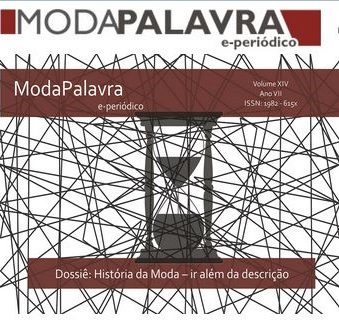Fashion, art and society: The pioneering maison Canada-de-Luxe and the emergence of the national fashion industry in the 1950s
DOI:
https://doi.org/10.5965/1982615x07142014028Keywords:
moda, vanguarda, elegânciaAbstract
Today, Brazilian fashion has prominence and international recognition for its distinctive style to create clothing and launch trends, a movement that seeks to unite the unique cultural diversity of Brazil to what is more contemporary and global in fashion design worldwide. However, the fashion system in Brazil has a history and its starting point goes back to the 1950s, furthermore, it was part of a large gear which articulated various industries and social sectors inside and outside the field of fashion. It is within this great gear that we can position the Canadá-de-Luxe and the creations of Mena Fiala – who never set out to create a fashionable Brazilian vanguard, but was relentless in the consolidation of a fashion tuned with was being produced outside Brazil, especially in Paris Post War fashion. Armed with an elaborate technique that she herself invented, never stopped developing it without abandoning the canons that constitute the style in fashion: effort, persistence and beauty. The house Canada’s benchmark comes to fashion in Brazil in the 1950s due to the tireless efforts of Mena Fiala and Cândida Gluzman in transforming the brand Canadá in reference of beauty and elegance.
Downloads
References
BARTHES, Roland. Sistema de moda. São Paulo: Martins Fontes, 1978.
BECKER, Howard. Art Worlds. Berkeley/Los Angeles: University of California Press, 1982.
CRANE, Diana. A moda e seu papel social: classe, gênero e identidade das roupas. São Paulo: Senac, 2013.
O Cruzeiro. Rio de Janeiro, ano 25, n. 7, 1952.
DURAND, José Carlos. Moda, luxo e economia. São Paulo: Babel Cultural, 1988.
GOMBRICH,Ernst H. A história da arte. Rio de Janeiro: LTC, 1999.
____. Arte e ilusão: um estudo da psicologia da representação pictórica. São Paulo: Martins Fontes, 1986.
KORNIS, Monica Almeida. Brasil de JK: sociedade e cultura nos anos 50. Disponível em http://cpdoc.fgv.br/producao/dossies/JK/artigos/Sociedade/Anos1950. Acesso em 12/03/2014.
LEÃO,Danuza. Quase tudo: memórias. São Paulo: Companhia das Letras, 2005.
MELLO E SOUZA, Gilda. O espírito das roupas: a moda no século XIX. São Paulo: Companhia das Letras, 1987.
MORAIS, Fernando. Chatô, o rei do Brasil. São Paulo: Companhia das Letras, 1994.
PANOFSKY, Erwin. Significado das artes visuais. São Paulo: Perspectiva, 1991.
PRADO, Luís André do; BRAGA, João. História da moda no Brasil. São Paulo: Disal, 2011.
SALLES, Joana Pedrassoli. Arte, moda e indústria no Brasil na década de 1950: Christian Dior, Jacques Fath e Elsa Schiaparelli. IARA – Revista de Moda, Cultura e Arte. Disponível em http://www.iararevista.sp.senac.br/arquivos/noticias/arquivos/49/anexos/pdf.pdf. Acesso em 11/03/2014.
SEIXAS, Cristina Araújo. A questão da cópia e da interpretação no contexto da produção de moda da Casa Canadá, no Rio de Janeiro na década de 1950. 2002. Dissertação (Mestrado em Design) — Curso de mestrado do Programa de Mestrado de Design, Departamento de Artes & Design, Pontifícia Universidade Católica do Rio de Janeiro.
SHAPIRO, Roberta. Que é artificação?. Sociedade e Estado, Brasília, v.22, n.1, p.135-151, jan./abr. 2007. Sombra. Rio de Janeiro, ano X, n. 101, maio 1950.
______. Rio de Janeiro, ano X, n. 105, set. 1950.
______. Rio de Janeiro,ano X, n. 107, nov./dez. 1950.
______. Rio de Janeiro, ano XI, n. 108, jan. 1951.
______. Rio de Janeiro, ano XII, n. 123, set./out. 1952. VIANNA, Hermano. O mistério do samba. Rio de Janeiro: Zahar, 2012.
Downloads
Published
How to Cite
Issue
Section
License
Copyright (c) 2014 Claudia Oliveira

This work is licensed under a Creative Commons Attribution-NonCommercial 4.0 International License.
When submitting an article for publication in ModaPalavra e-periodico, the author (s) agree (s) with the following terms:
- Authors maintain the copyright in their manuscripts and grant the journal the right of first publication, with work simultaneously licensed under the Creative Commons Attribution-NonCommercial 4.0 International, which allows sharing the work with the acknowledgment of authorship and the initial publication in the journal without payment ;
- Authors may use the same results in other publications after the first publication, provided that they indicate ModaPalavra e-journal as the original publication medium;
- Authors are authorized to take additional contracts, separately, only after the original publication in ModaPalavra e-journal, provided they indicate ModaPalavra e-journal as the original publication medium;
- Authors are allowed and encouraged to publish and distribute their work online (eg in institutional repositories or on their personal page), only after the editorial process and the first publication, provided they indicate ModaPalavra e-journal as the original publication medium;
- To indicate ModaPalavra e-journal as the original publication medium, authors should use the following text template: "This article was originally published by ModaPalavra e-periodical, under a CC BY NC license, in its volume [insert volume] number [insert number] in the year of [insert year], and can be accessed at: http://www.revistas.udesc.br/index.php/modapalavra/ ";
- The opinions expressed in the articles are the author’s sole responsibility, not necessarily reflecting the journal’s opinion. The publication of any material that is owned and held in copyright by a third party, including – but not limited to - articles, photos or drawings was previously authorized by their representatives to be published in ModaPalavra e-journal.










